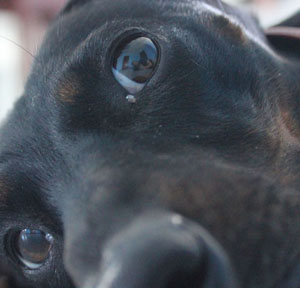
Dr. Ruth MacPete talks about the importance of eye care for your pet. For more from Dr. MacPete, find her on Facebook!
January is the perfect time to talk about eyes because it’s National Eye Care Month! Dogs and cats, like their human companions, can develop a variety of eye problems. Since pets can’t tell us if their vision is blurry or if their eyes hurt, it is our job to become familiar with common pet eye conditions and learn to recognize the signs and symptoms of an eye issue. So what are some of the most common eye problems seen in dogs and cats?
1. Conjunctivitis
Refers to inflammation of the conjunctiva (the clear membrane covering the eye). Instead of being transparent, the conjunctiva becomes red and swollen. It can be caused by a virus, bacteria, or less commonly by allergies. In cats, feline herpes virus and chlamydia are common causes of conjunctivitis.
2. Corneal Ulcers
Corneal ulcers are a defect or break in the outer layer of the cornea. In animals, they are usually due to a scratch from another animal, plant or object. Corneal ulcers are painful and the eyelids are often closed or squinting. Gone untreated, they can become infected.
3. Foreign Bodies
Dogs and cats get things in their eyes when they are walking through brush. Foxtails (a type of weed found in the Southwest), cactus spines, and thorns can stick to an animal’s cornea or get trapped under their eyelids. Ocular foreign bodies are painful and can lead to a corneal ulcer and infection if not promptly removed.
4. Cataracts
Cataracts occur when the lens becomes opaque and blocks light from reaching the retina. How much vision is affected depends on the density of the cataract. Cataracts can develop following an injury to the eye or from uncontrolled diabetes mellitus in dogs. Cataracts can also be congenital (present at birth) or can develop with aging.  5. Retinal Detachment
5. Retinal Detachment
A detachment of the retina occurs when the retina separates from the underlying tissue. In animals, retinal detachments are often a sign of a systemic problem, such as high blood pressure due to kidney disease. Uncontrolled high blood pressure causes accumulation of fluid under the retina resulting in a detachment.
These are just a few common ocular issues seen in cats and dogs. Like people, animals can also develop other problems such as glaucoma, dry eye, and uveitis to name a few. So now that you know about some of the most common eye problems in pets, how do you know if your animal is having a problem? Since our pets can’t talk to us, we have to look for signs of a potential problem. The signs of a possible eye problem include:
- Excessive tearing
- Squinting
- Ocular discharge or gunk in and around the eye
- Pawing at the eye or rubbing their face a lot
- Red or inflamed eyes
- Bumping into walls, furniture, people or other animals
- Closed eyes
- Cloudy eye
- Avoiding the light
- Bulging or swollen eye
Remember to keep an eye (no pun intended) out for these common signs and symptoms. If you notice any of these or have any concerns about your pet’s eyes see your veterinarian right away. When it comes to eyes don’t mess around! Left untreated ocular issues can progress and even lead to blindness.
If you have any questions or concerns, you should always visit or call your veterinarian – they are your best resource to ensure the health and well-being of your pets.
![]()
